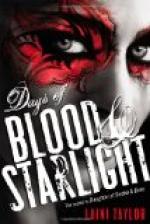“Then I should like another,” Kendal interrupted.
“I’m going to do a descriptive article for the Age; the editor wants to call it ‘Through the Studios,’ or something of that sort—about the artists over here and their ways of working, and their places, and their ideas, and all that, and I thought, if you didn’t mind, I should like to begin with you. Though it’s rather like taking an advantage.”
“But are you going in for this sort of thing seriously? Have you ever done anything of the sort before? Isn’t it an uncommon grind?” Kendal asked, with hearty interest. “What made you think of it? Of course you may say any mortal thing you want to about me—though I call it treachery, your going over to the critics. And I’m afraid you won’t find anything very picturesque here. As you say, we’re not in Paris.”
“Oh yes, I shall,” she replied sweetly, ignoring his questions. “I like pipes and cobwebs and old coats hanging on a nail, and plenty of litter and dust and confusion. It’s much better for work than tapestries and old armour and wood-carvings.”
Miss Bell did not open her little black notebook to record these things, however. Instead, she picked up a number of the London Magazine and looked at the title of an article pencil-marked on the pale green cover. It was Janet Cardiff’s article, and Lady Halifax had marked it. Elfrida had read it before. It was a fanciful recreation of the conditions of verse-making when Herrick wrote, very pleasurably ironical in its bearing upon more modern poetry-making. It had quite deserved the praise she gave it in the corner which the Age reserved for magazines. “I want you to understand,” she said slowly, “that it is only a way. I shall not be content to stick at this—ordinary—kind of journalistic work. I shall aim at something better—something perhaps even as good as that,” she held up the marked article. “I wonder if she realizes how fortunate she is—to appear between the same covers as Swinburne!”
“It is not fortune altogether,” Kendal answered; “she works hard.”
“Do you know her? Do you see her often? Will you tell her that there is somebody who takes a special delight in every word she writes?” asked Elfrida impulsively. “But no, of course not! Why should she care—she must hear such things so often. Tell me, though, what is she like, and particularly how old is she?”
Kendal had begun to paint again; it was a compliment he was able to pay only to a very few people. “I shall certainly repeat it to her,” he said. “She can’t hear such things often enough—nobody can. How shall I tell you what she is like! She is tall, about as tall as you are, and rather thin. She has a good color, and nice hair and eyes.”
“What colored eyes?”
“Brown, I think. No—I don’t know, but not blue. And good eyebrows. Particularly good eyebrows.”
“She must be plain,” Elfrida thought, “if he has to dwell upon her eyebrows. And how old?” she asked again. “Much over thirty?”




